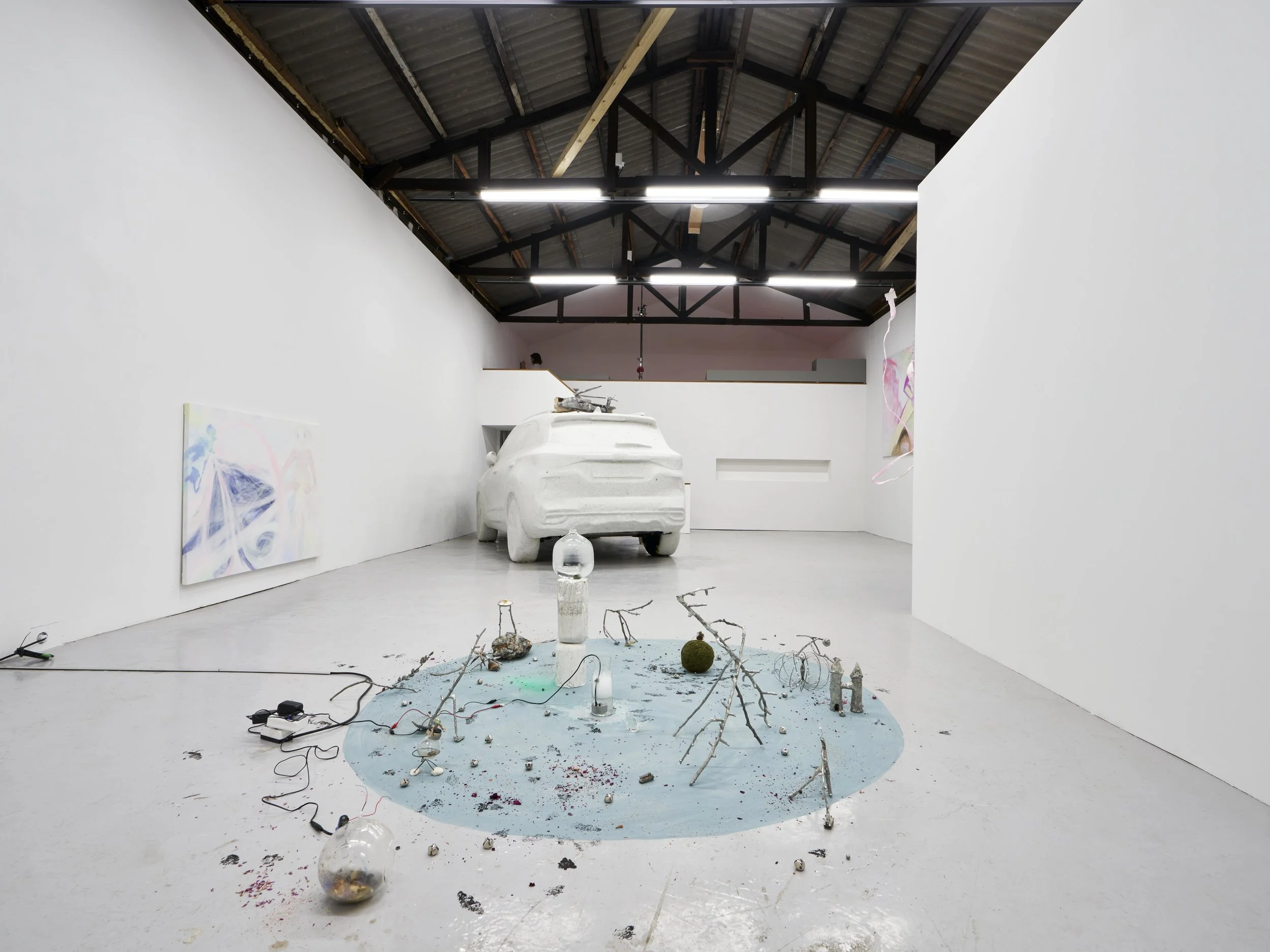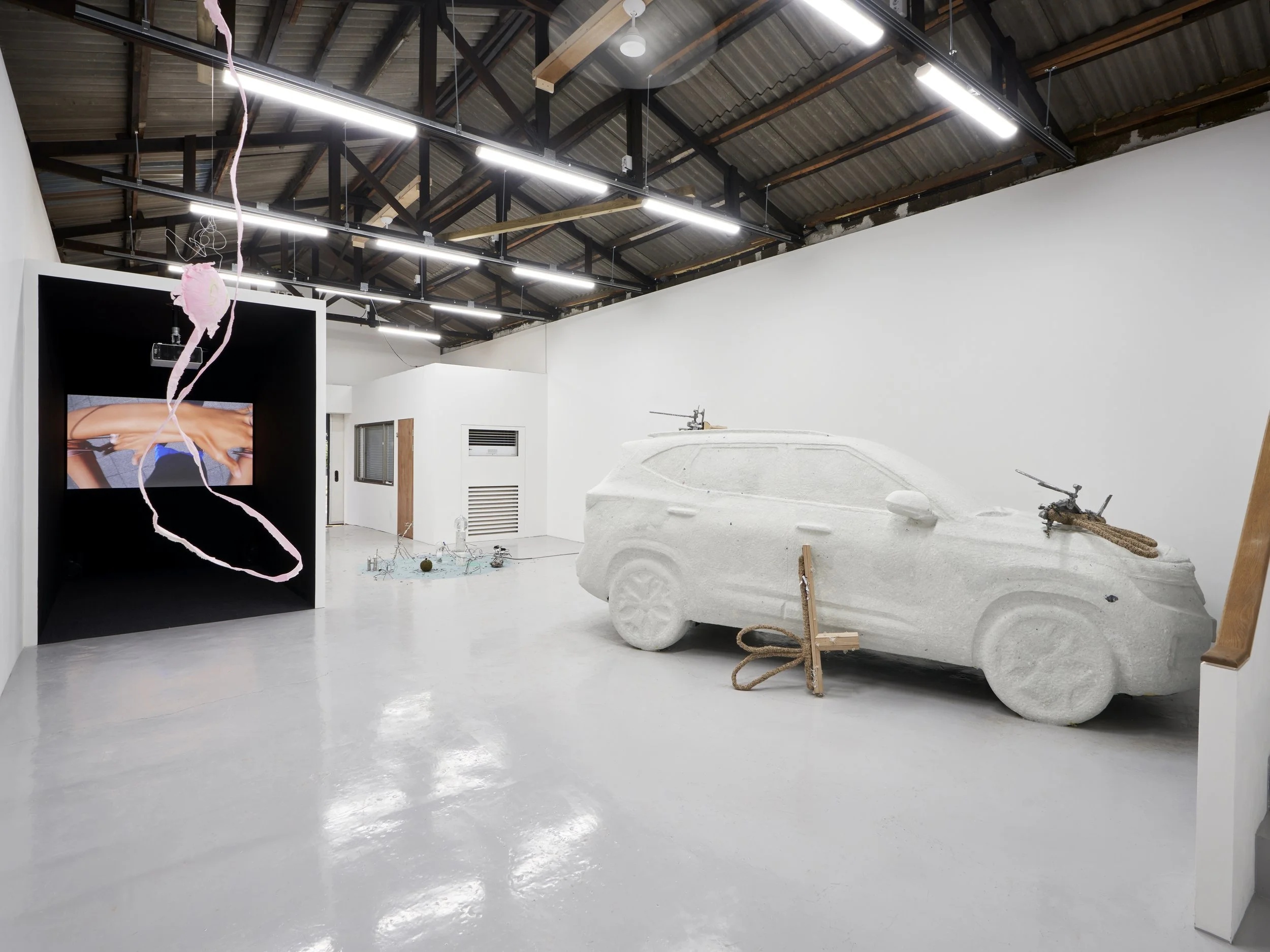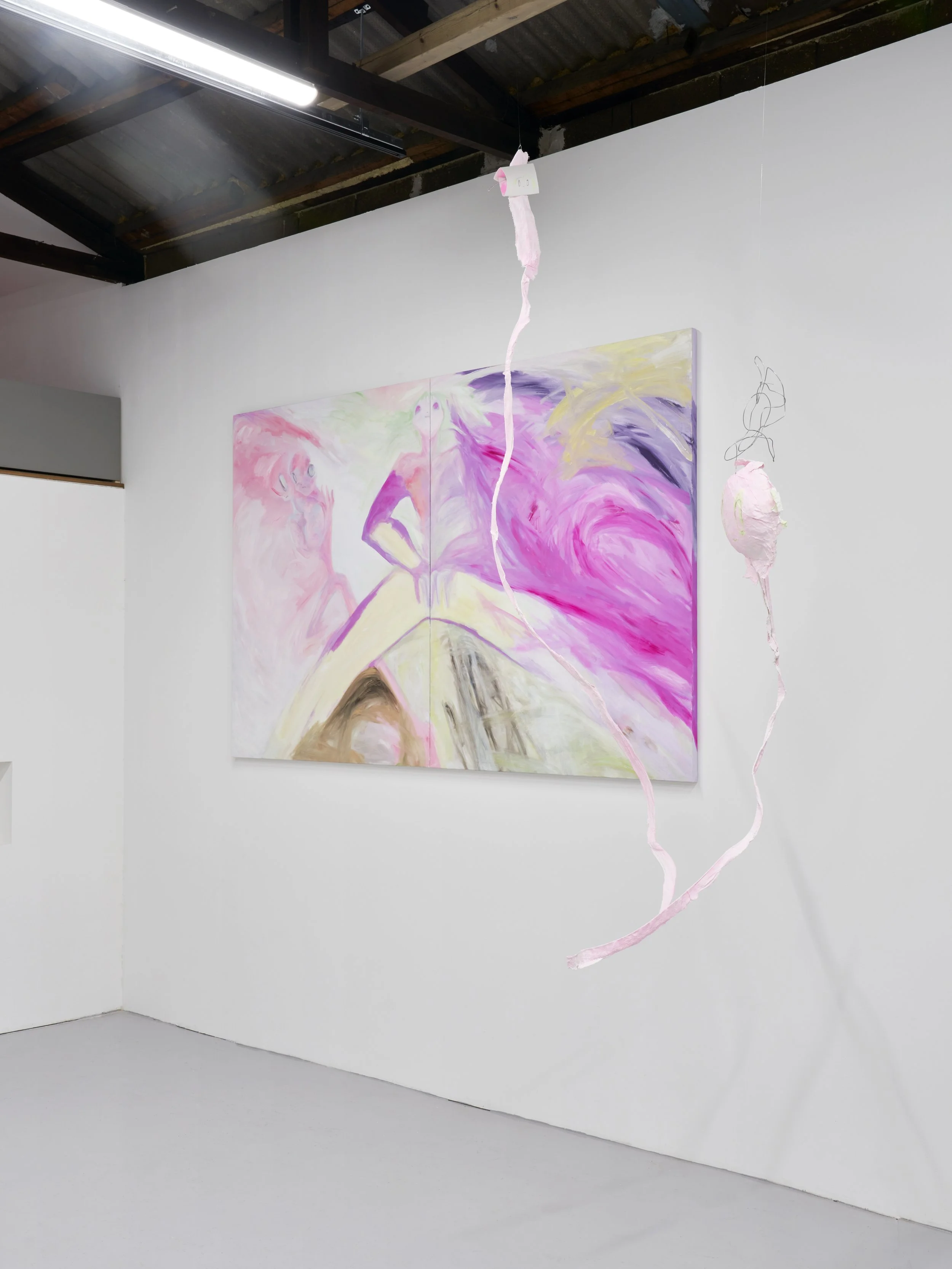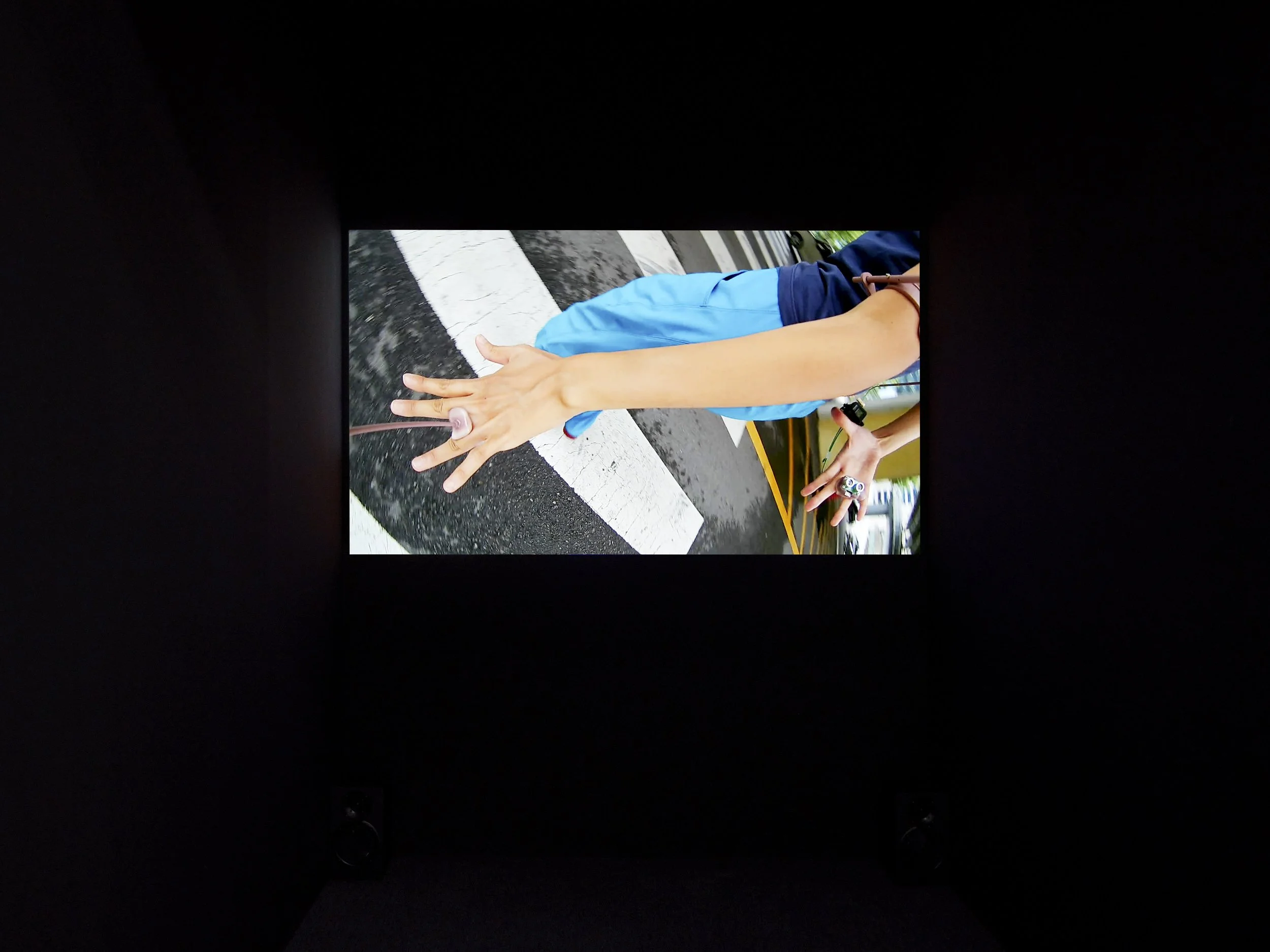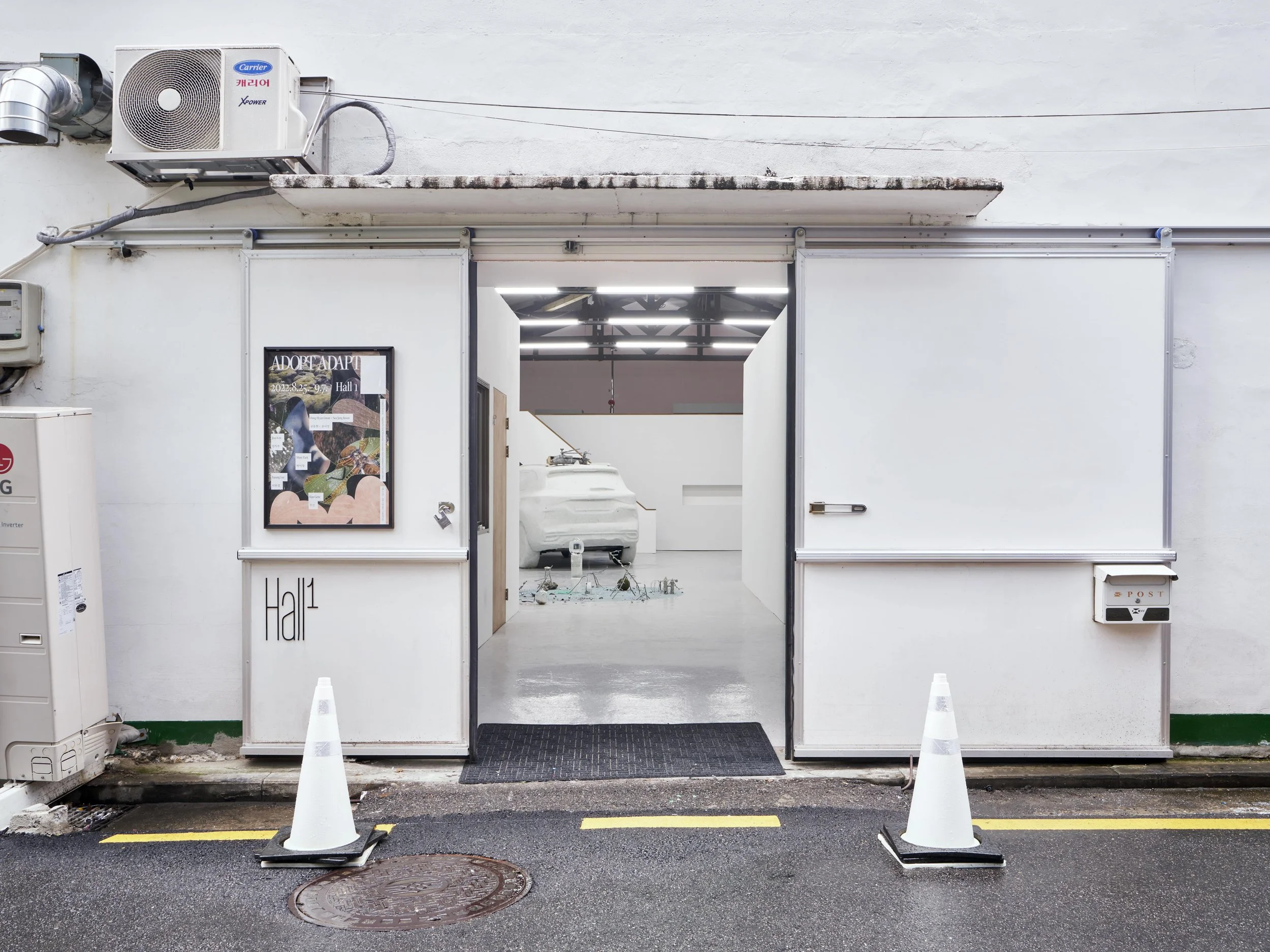Adopt Adapt
Dong Hyun Gwon × Sea Jung Kwon, Jisu Kim, Mimi Park, Eusung Lee, Han Gene
권동현×권세정, 김지수, 박미정, 이유성, 한진
25 August - 7 September, 2022
Hall 1, Seoul
ADOPT ADAPT는 결함 있는 신체와 미지의 타자, 그리고 함께 살아가는 법에 대한 프로젝트다.
2017년 가을에 촬영한 MRI에서 요추 5번과 6번 사이 디스크가 소량 튀어나와 신경을 건드리고 있는 것을 확인했다. 몇 주 전 어깨가 아파 가방의 무게를 등으로 옮겨주는 구조의 가방을 사용한 것이 화근이었다. 후면 근육이 빈약한 상태로 하중이 척추로 집중되어 사단이 난 것이다. 수개월간 극심한 통증에 시달린 끝에 다시는 이렇게 아프지 않으리라는 결심을 했다. 적절한 치료와 재활 운동을 통해 1여 년 만에 다시 허리를 폈다. 간헐적으로 요통이 찾아오기는 했지만, 꾸준한 운동과 습관 교정으로 관리해왔던 터라 크게 걱정하지 않았고, 며칠 안 가 금방 낫는 걸 보며 더 이상 잘못될 일은 없다고 믿었다.
하지만 2022년 2월, 오미크론에 감염되어 고열과 몸살에 시달리던 차에 불길한 감각이 허리를 관통했다. 오랜 친구 혹은 원수의 뒤통수처럼 익숙한 느낌, 디스크 통증이었다. 하지만 이번에는 달랐다. 숨쉬는 것이 무서울 정도로 작은 움직임에도 허리에 불이 난 것처럼, 날카로운 칼날이 속을 도려낸 것처럼, 전동드릴이 구멍이라도 뚫고 있는 것 같은 고통이 우측 엉치에서 시작해서 다리 뒷면을 따라 발바닥까지 사로잡았다. 일주일 만에 코로나바이러스는 가셨지만, 여전히 침대에서 일어날 수 없었다. 다량의 진통제를 먹고 겨우 일어났을 때, 오른쪽 다리가 말을 듣지 않는다는 걸 깨달았다. 허벅지와 종아리는 물컹해졌고, 오른쪽 발을 오므릴 수 없을 만큼 신경에 손상이 갔던 것이다. 이미 정복했다고 생각한 질병이었기에 내가 아는 최선의 대처를 했지만 아무런 차도가 없었다.
나의 상태를 전해 들은 가족과 동료, 심지어 초면인 이들까지 안타까워하며 본인이나 주변인이 효과를 봤다는 치료법이나 용하다는 병원을 추천했다. 내가 모든 일을 그만두고 회복에만 주력해야 한다고, 심지어는 내가 이제까지 너무 열심히 일을 했기 때문에 대가를 치르는 것이니 경각심을 가져야 한다고 힘주어 말하기도 했다. 이 지면을 빌어 걱정과 응원을 표해준 모두에게 고마운 마음을 전하고 싶다. 하지만 치료에 대한 구체적인 논의가 추상화될 때 애정의 마음은 억압의 논리로 둔갑한다. 회복의 패러다임은 현재 상태를 명확한 원인으로 인한 일시적인 비정상성으로 규정하고, 본래대로 원상 복귀하는 것을 우선시함으로써 엄연히 존재하는 현재의 신체를 은폐하거나 통제의 영역으로 포섭하기에 이른다. 이는 각기 다른 신체의 역능에 차이가 있으며, 동일한 신체도 시기와 상황에 따라 유동적으로 존재한다는 현실을 가린다. 회복이라는 가능성의 영역에 가려진 당장의 신체적/신경적 다양성에 대해 급진적인 리얼리즘을 적용한다면, 어떤 세계를 그려볼 수 있을까? 설령 회복이 보장되더라도 그 여정을 단지 사적인 영역에 가두는 것이 아니라 공동체적, 사회적 구간으로 이해한다면, 우리는 어떻게 연결될 수 있을까? 서로 다른 형태와 역능을 지닌 신체들이 있는 그대로 상호 적응하기 시작하면 어떤 일이 일어날까?
누워 있다고 통증이 가시지 않는다. 차라리 일어나보는 편이 낫겠다. 자꾸 무너지는 상반신을 지지하기 위해 찍찍이로 고정하고 코르셋처럼 실을 잡아당겨 강도를 조절하는 복대를 찬다. 끝에 고무 팁이 달려 있고 LED 라이트까지 장착된 알루미늄 합금 지팡이를 쥔다. 둔탁해진 오른 다리와 검정 막대기에 무게를 분산하여 걷기 시작한다. 평소에 5분이면 도착할 거리를 30분에 걸쳐 아주 좁은 보폭으로, 걷다 서기를 반복하며 편의점에 도착한다. 쌀쌀한 날이지만 온몸이 땀에 젖는다. 시원한 탄산수를 마시며 현재 몸이 움직이는 방식과 통증을 비롯한 감각을 인지한다. 지금의 상태가 얼마나 지속될지 알 수도 없고, 굳이 괘념치 않는다. 나를 지탱하는 도구들과 더불어 움직일 때 발생하는 동작을 관찰한다. 새로 조직된 신체는 과거 익숙했던 지형, 기물, 그리고 다양한 신체와 관계 맺는 방식을 다시 배워야 한다.
이 경험이 중요한 전환점이 되기는 했지만 ADOPT ADAPT는 요통이 찾아오기 전부터 준비하던 프로젝트였다. 2020년에 시작한 리서치 프로젝트 ‘머티리얼 스터디’는 미술 실천이 인간 주체의 일방적인 의도 및 담론의 틀에서 논의되는 경향에 대한 문제 의식을 바탕으로, 미적 경험을 가능하게 하는 물질을 주요 행위자로 재발견하고자 했다. 창작 계획을 배반하고 최종 작품의 형태를 조작하는 재료, 기획 의도를 초과하는 물질적 환경, 예상치 못한 효과를 산출하는 사물의 배치를 은폐해야 할 사고가 아니라 미술 실천을 재발견할 출발점으로 보고자 한 것이다. 비인간 행위자를 수단 혹은 객체에 한정하지 않고 미술 실천의 협력자이자 가공할만한 변수로 인식할 때, ‘정상적’ 인간(백인-비장애인-남성-부르주아)을 상정한 근대적 제도 너머의 장면과 언어를 포착할 수 있을 거라 생각한 것이다. 여러 창작자와의 대화 및 신유물론, 장애학, 매체론을 가로지른 학제적 탐구를 이어가던 중 내게 찾아올 일을 예견이라도 하듯 비정상 혹은 결핍으로 정의되는 신체와 도구(혹은 도구화된 존재 사이의 관계에 흥미를 느꼈고, 이를 적응이라는 테마로 다뤄보고자 했다.
프로젝트의 제목은 유사한 발음의 두 단어를 나란히 붙인 것이다. 하나(Adopt)는 선택 혹은 사용을 뜻하고, 다른 하나(Adapt)는 적응을 뜻한다. 도구나 반려 존재를 선택하는 일은 전적으로 인간의 영역에 있는 것으로 간주되곤 한다. 하지만 사용과 동거의 과정은 철저한 의지의 영역을 넘어 서로의 존재가 유기적으로 포개지는 과정이다. 함께 사는 인간 및 비인간 존재는 함께 공기와 타액을 공유하고, 도구는 사용이 반복될수록 낡아가는 동시에 사용자의 자세를 바꾸거나 굳은살을 준다. 각기 다른 존재들이 함께 호흡을 맞춰 춤을 출 때 언어적 소통을 초과한 이해에 다다른다. 이 제목은 존재의 위계 및 미리 결정된 사용 의도, 나아가 이질적인 존재에 대한 일방적인 혐오와 연민을 넘어선 장면, 즉 선택과 사용이 궁극적으로 적응과 포개진 양태들을 가리킨다.
이 프로젝트는 적응에 대한 두 가지 이해를 바탕으로 한다. 하나는 객체 지향 존재론을 정립, 주장한 레비 브라이언트(Levi R. Bryant)가 재해석한 생물학적 개념인 굴절적응이다. 굴절적응은 본래 특정한 기능을 갖고 있던 생물의 일부분이 또 다른 기능에 사용되면서 나타나는 적응 형질이다. 브라이언트는 이 개념을 무생물인 사물로 확장 적용하여 도구를 비롯한 비인간 존재가 언제나 인간의 명령을 따르는 것이 아니라 독자적으로 활동한다는 점을 드러낸다. 가령 망치는 못을 박기 위해, 못은 무언가를 고정하는 데 쓰인다고 알고 있다. 하지만 모든 사물은 원천적으로는 다기능적이다. 망치는 종이를 눌러 두는 문진의 역할을 할 수도 있고, 못은 잘못 밟은 이의 발에 상처를 내는 무기가 될 수도 있다. 기계가 다른 기계와의 상호작용 속에서(망치와 종이 혹은 못과 발의 접촉) 그 기능과 궁극적인 효과가 결정된다면, 비인간 존재 또한 절대적으로 고정된 것이 아니라 수행적으로 구성된다고 볼 수 있겠다.
다른 하나는 동물 세계에서 찾아볼 수 있는 학습된 적응의 양상이다. 흔히 공감 능력, 즉 다른 개체의 입장에 서서 생각하는 힘은 인간에게만 있다고 여겨진다. 따라서, 역지사지의 능력이 결여된 동물 세계는 적자생존의 논리를 따라 열등한 개체를 배제할 거라고 예상하기 쉽다. 하지만 수나우라 테일러(Sunaura Taylor)는 여러 동물이 공감 능력을 갇췄다는 연구 결과를 제시하며 이에 반박한다. 나아가 영장류 학자 드 발(Edmund De Waal)의 논의를 통해 동물이 장애를 가진 개체에 대해 인지적 공감을 발휘하지 못할 때라도 그 제약을 알아가며 함께 살아간다는 점을 지적한다. 가령, 반려견은 반려인이 손을 잃으면 동정은커녕 그것이 무슨 의미인지 인지하지 못한다. 하지만 손이 아닌 발로 공을 던져주거나 쓰다듬어 주면 이 변화에 충분히 적응할 수 있다. 물론 이러한 학습된 적응이 언제나 이상적인 공존에 이르리라는 보장은 없다. 하지만 인간이 공감의 능력을 과신할 때 초래되는 결과, 즉 타자의 장애나 상이한 특질을 쉬이 예측, 진단하여 고정관념을 발동시키는 사고 습관에 대한 대안이 될 수 있다. 판단하기 이전에 공을 주고받으며 서로의 행동반경을 알아가는 태도가 공감하는 따뜻한 말보다 열등하다고 판단할 근거는 없다.
이러한 기반에도 불구하고 두 단어, 특히 그중 적응을 뜻하는 단어를 제목에 내세우기까지는 많은 고민이 있었다. 우선 진화생물학에서는 적응의 의미를 개체가 생존에 적합한 방식으로 진화하는 양상으로 한정한다. 이에 따라 적응이라는 단어에는 우월한 개체가 되기 위한 노력이라는 함의가 기입되어 있다. 다른 한편으로, 치료를 통해 회복을 꾀해야 하는 질병의 사례에서는 적응하라는 메시지가 오히려 절망적으로 다가올지 모른다. 나아가 장애인을 비롯한 주변화된 사람들이 이들을 비인간화하는 사회의 구조적 차별에 맞서 인간성을 인정받기 위해 투쟁해왔던 점을 생각하면 인간과 비인간이 평평하게 결합되어 포개지는 장면은 썩 고무적이지 않을 수 있다. 이러한 모순은 이 프로젝트를 통해 해결될 수 없지만 오히려 해결할 수 없기에 동력으로 작용했다. 적응이 생존과 직결된다면, 생존의 의미를 다시 써야 하지 않을까? 우리의 몸이 온갖 부상과 노화에 취약하다면, 이러한 현실에 응답하지 않는 천편일률적 구조물이 바로 부적응의 결과가 아닌가? 단지 미관상의 이유로 무해한 신체의 일부를 절단하거나 반대로 생존을 위해 절단해야 하는 사지를 목숨 걸고 남기는 종류의 ‘치료’를 요구하지 않는 미관을 구상해야 하지 않을까? 비인간 혹은 비유기물과 우리를 평평하게 바라보는 사유가 인간의 비인간화 작용을 무력하게 하는 단초가 될 수 없을까?
큐레토리얼 프로젝트로서 ADOPT ADAPT가 하고자 하는 것은 이러한 논의를 물질의 배치를 통해 열어 보이는 것이다. 개인적인 경험과 문제의식, 대화와 담론을 통해 이르게 된 질문은 일종의 상상적 도약을 요구한다. 이질적인 형태 및 물질의 결합으로부터 미적 쾌를 느끼는 것, 감지하기 어려운 먼지나 수증기부터 차량 및 기물까지 서로 다른 단위를 관찰하기 위해 끊임없이 높낮이와 거리를 조정하는 일, 시야에 중첩되어 다가오는 요소를 반목하는 존재가 아니라 흥미로운 패턴으로 해석해내는 접근. 다섯 명(팀)의 창작자와 함께 이런 일들이 일어나기를 꿈꾸었다. 마른 꽃잎과 곤충의 흔적을 따라가 바닥에 펼쳐진 작은 우주를 경험하고(박미정), 눈을 들어보면 SUV 스케일의 좌대 위에 올려진 유기물-인공물-상징물의 합성 조각과 마주하며(이유성), 그 와중에 기계와 결합한 신체가 도심에서 펼치는 움직임이 곧 리드미컬한 사운드로 치환돼 공간을 울린다(김지수). 인체의 한계를 넘어선 상상적인 존재를 통해 펼치는 잉태와 분열의 장면에 몰입하거나(한진), 인간과 비인간 사이 중간 존재의 관점에서 전시장의 풍경을 조망할 수도 있다(권동현×권세정). 타자의 체화된 경험을 내 것으로 만들 수 없을 때 반목하는 대신 서로 적응하며 굴곡진 지형을 만들고, 그 어떤 ‘결핍’의 순간이라도 존재하기를 멈추지 않는 시공간을 함께 상상하면 좋겠다.
참고문헌
도나 해러웨이, 『해러웨이 선언문』, 황희선 역, 책세상, 2019.
레비 R. 브라이언트, 『존재의 지도』, 김효진 역, 갈무리, 2020.
레비 R. 브라이언트, 『객체들의 민주주의』, 김요진 역, 갈무리, 2021.
제인 베넷, 『생동하는 물질』, 문성재 역, 현실문화, 2020.
수나우라 테일러, 『짐을 끄는 짐승들』, 이마즈 유리 역, 오월의봄, 2020
스티븐 샤비로, 『사물들의 우주: 사변적 실재론과 화이트헤드』, 안호성 역, 갈무리, 2021.
Ian Bogost, Alien Phenomenology, or What It’s Like to Be a Thing, University of Minnesota Press, 2012.
Ursula K. Le Guin, The Carrier Bag Theory of Fiction, 1986.
ADOPT ADAPT is about bodies with defects, the unknown others, and ways to coexist with them.
In the fall of 2017, the MRI scan of my spine revealed a slipped disc between L5 and L6, poking at the nerves that ran behind it. It all began with a backpack I started using a few weeks back, which got good reviews for applying less pressure on the shoulder. Little did I know that its secret was concentrating all its weight on the back, where I had little muscle to support it. Weeks of intense pain left me determined never to let myself go through the ordeal again. With proper treatment and the right exercise over a little more than a year, I was able to stand up straight again. There were times when the pain returned briefly, but I was confident that it would pass since I was taking good care of myself.
Five years go by. I was in bed with a fever and aches all over from omicron when I felt it. I knew what it was right away, like recognizing an old friend. The disc was once again out and about. But it was much worse this time. It felt like my back was on fire, a knife was scraping out the nerves on the back of my right leg, and drills coming at my hip at full throttle. I was free of the virus in a week, but I was still bedridden. When I gulped down a handful of painkillers, I was finally able to gather myself to stand, only to realize that my right leg wasn’t what it used to be. The thigh and the calf felt suspiciously mushy, and two of my toes wouldn’t bend at my will. Everything I knew to be the proper treatment was already done, but I was still in excruciating pain.
The news or the apparent look of my ailment was followed by a slew of treatment and clinic recommendations by family, friends, colleagues, and even strangers. Some would solemnly advise me to take a break from work entirely and focus on recovery, telling me this was a punishment for working myself too hard and to take this warning seriously. My sincere thanks go to all of those who have supported me through this time. However, the talks about recovery at some point stopped being about my specific case, and shifted quickly to a paradigm operated as an oppressive construct. The paradigm of recovery identifies the present pain as a temporary deficiency caused by a clear-cut cause. It prioritizes efforts to get back to the original state, which leads to suppressing and controlling the present condition. Furthermore, it refuses to face reality where there are bodies of varying degrees and natures of powers that are vulnerable to myriads of circumstances and mostly out of the beholder’s control. What if we set aside the idea of the recovered future and instead apply a radical realism that faces physio-neuro-diversity? What kind of connection would be possible if the state of vulnerability is shared among the society and community rather than confined to the individual until recovery is complete? What happens when bodies of varying forms and powers decide to coexist and adapt to one another without the obligation to become wholesome?
To my surprise, lying down does not alleviate the pain at all. I should try walking. I put on a belt with a Velcro strip on the ends and adjustable strings on the back like a corset. This will hold my floppy upper body straight. Then I grab an aluminum walking stick with a rubber tip on the bottom and a light switch on the handle. Trying to find the least painful angle to pick up my foot and somehow manage my lazy leg, I give a shot at what could barely be walking. What used to be a five-minute walk to the convenience store becomes a thirty-minute journey of insufferable short steps and frequent breaks. Soaked in sweat, I grabbed a bottle of sparkling water. As I drank to regain energy for the return trip, I took in how my body moves, feels, and is seen. There is no timeframe and progress chart available to manage my condition. The only option is to observe the movements I make with the objects that support me. My new body had to will have to learn to work with its surroundings and other bodies. All over again.
Although my personal experience had an impact, I began thinking about ADOPT ADAPT before the pain hit. Material Studies, a research project that started in 2020, set out to redefine the materials that initiate aesthetic experiences as a prominent actor, questioning the persistent tendency to locate thematic issues and human intentions at the center stage of artistic discourse. It highlighted how materials betray the design and manipulate the resulting artwork, the material conditions that exceed the curatorial directions, and assemblages of objects that generate unexpected effects not as a series of accidents to suppress but the very core of artistic practice. By rediscovering non-human objects as key practitioners and collaborators, the project attempted to formulate languages and conditions beyond the modern institution that presupposes white/abled/cis-gendered/male/bourgeois as its key players. Conversations with various makers and interdisciplinary research across new materialism, disability studies, and media theory led me to an interest in the relationship between bodies with a lack and objects (or objectified beings), as if I knew it would soon be a story I know so well.
The title of the project puts together two words that sound similar. One – “adopt” – indicates selection or use while the other – “adapt” – adjustment. Choosing an object to use or a being to coexist is conventionally recognized as human behavior dependent on will. However, such human acts go beyond pure will and actively involve unintended entanglement. Cohabitating humans and non-human beings share air and fluids as they grow closer, while a tool changes the habits and posture of the user and at times leaves behind tangible traces. An act of adoption is more like dancing in tune with one another than executing a program, exceeding the realm of linguistic understanding. ADOPT ADAPT imagines a world beyond the hierarchy of beings and predetermined purposes and in turn, unilateral hate or compassion toward the unknown other. It sets out to explore how selection and usage are simultaneously adjustments among divergent beings.
This project draws from two notions of adaptation. One is exaptation elaborated by the philosopher of object-oriented ontology Levi R. Bryant. As a concept in evolutionary biology, exaptation describes a trait that has been repurposed, serving a role other than the one designed by nature in the course of evolution. Bryant takes this notion to describe not only the living organisms but also objects, arguing how non-living things, even tools that are seen as designed for particular human purposes, have agency. A hammer in the hands of a willing human is used to drive a nail. However, all objects are inherently multipurpose. A hammer on pieces of paper could unintentionally become a paperweight, while nails could inadvertently be a weapon that hurts the feet that step on them. If an object’s function and effect are determined by its interaction with other objects, non-human beings are no less performative than their human counterparts.
On the other hand, there is a notion of learned adjustment observed among animals. More often than not, humans are considered the only beings that are capable of putting themselves in the other’s shoes. Moreover, if this is true, non-humans that lack empathy is expected to follow the law of survival of the fittest, granting no mercy to the weaker. However, Sunaura Taylor presents multiple cases where animals demonstrate their ability to empathize. And even without cognitive empathy, according to primatologist Edmund De Waal, non-human beings have shown ways to learn one another’s capabilities and adjust their behaviors accordingly. For example, when a person loses her arms, her companion dog may not comprehend the gravity of this change and what this might mean for the human. However, when the human begins throwing the ball or strokes her with a foot instead of a hand, the dog will surely adapt to the shift and know how to act around her. Of course, the learned adjustment does not guarantee an ideal coexistence. Yet it opens a new possibility that is alternative to the overconfidence in its ability to understand others’ embodied experience, which could lead to simplification, prognosis, and stigmatization of disabilities and peculiarities. There are no solid grounds to assert superiority of heartfelt words over playing catch to learn how the other moves.
Despite the discursive context mentioned above, there was still hesitation in directly presenting the word in the title. In evolutionary biology terminology, adaptation indicates adjustments organisms make to improve the chances of survival. The word is inscribed with a battle to be the fittest in the eyes of natural selection. Also, the message of adaptation is not the most cheerful when it comes to detrimental diseases that require intense treatment, and whose access is not equally distributed. Furthermore, we also have to take into consideration the struggles of the marginalized people who face structural discrimination that strategically dehumanizes them. Democracy among human and non-human beings, notably in its abstracted versions, may come across as complicit to the preexisting system for those who fought to be recognized as humans. This project does not insist on solutions for these dilemmas. Rather, its main drive is navigating through them and asking yet more questions: If adaptation is aligned with survival, isn’t it time to dismantle and redefine survival? If our bodies are vulnerable to all kinds of ailment and aging, how are the unadapted and homogeneous social structures and physical establishments not a failure? If the human species is used to procedures that sever body parts – i.e., malign cases of polydactylism – or keep them at the expense of risking lives to meet society’s standards - i.e., deathly infections by the limbs, should we not consider readjusting the notion of normality? Is there a potential in uplifting non-human or non-living beings as prominent actants for undermining structural dehumanization?
As a curatorial project, ADOPT ADAPT attempts to open up this discussion through an assemblage of objects. The questions drawn from personal narratives, discussion, and artistic practice demand a leap of imagination, to appreciate the aesthetic values of combinations of heterogeneous forms and materials, repeatedly adjust one’s point of view among objects of varying scale, and explore overlapping elements not in terms of antagonism but discovering interesting patterns. The vision was shared among five participating artists/teams and me. Led by dried plants and insect-shaped stamps, the exhibition opens with a small universe placed on the floor that requires you to squat or get on your knees (Mimi Park). Behind it is a vehicle-turned-pedestal where organism-artifact-symbol hybrid sculptures sit. The observation will take place while the movement of the body wearing an instrument is translated to a rhythmical sound that echoes around the space (Jisu Kim). One might be mesmerized by the birth or fission of imaginary beings that exceed the limits of the human body (Han Gene) or reflect on the history of the city and dogs while enjoying the view of a not-quite-animal but not-yet-human being (Dong Hyun Gwon × Sea Jung Kwon). The assemblage will allow the imagination of flexible and irregular grounds of heterogeneous beings whose embodied experience we may never have access to and a society where we never stop living or go invisible even in times of arbitrarily defined deficiency.
Bibliography
Ian Bogost, Alien Phenomenology, or What It’s Like to Be a Thing, University of Minnesota Press, 2012.
Jane Bennett, Vibrant Matter: A Political Ecology of Things, Duke University Press Book, 2010.
Levi R. Bryant, Democracy of Objects, Studium Publishing, 2018.
Levi R. Bryant, Onto-Cartography: An Ontology of Machines and Media, Edinburgh University Press, 2014.
Steven Shaviro, The Universe of Things: On Speculative Realism, University of Minnesota Press, 2014.
Sunaura Taylor, Beasts of Burden: Animal and Disability Liberation, The New Press, 2017.
Ursula K. Le Guin, “The Carrier Bag Theory of Fiction,” 1986.
